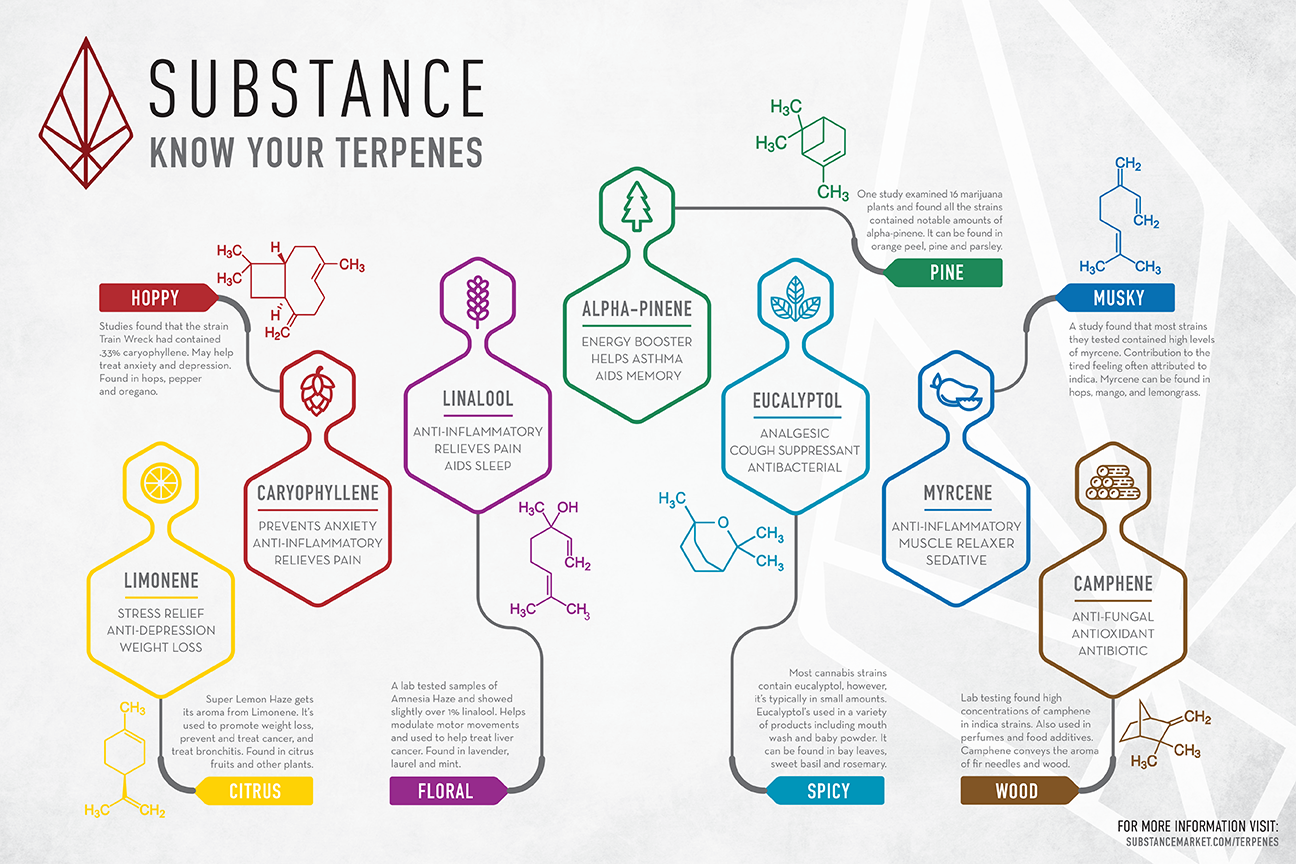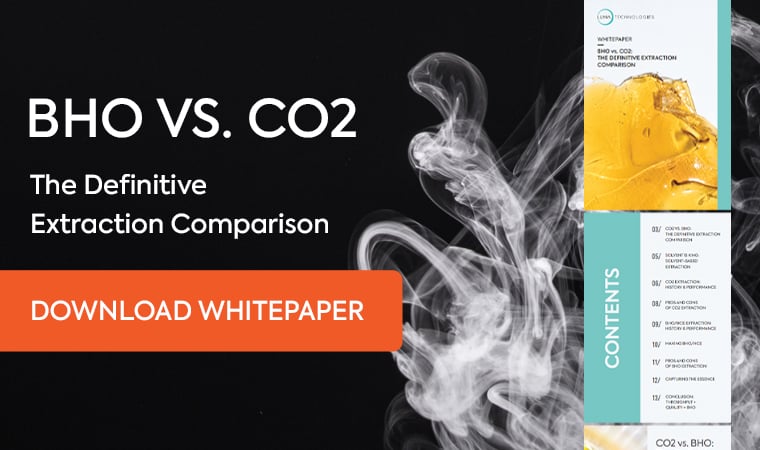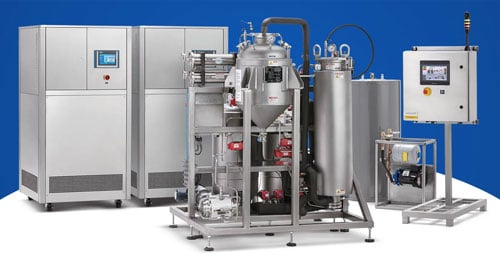What Is Butane?
Butane is a light hydrocarbon belonging to the same molecular family consisting of ethane, propane, and methane. Butane is produced from crude oils derived from decaying organic matter buried deep underground. Fractional distillation purifies the crude oil and compresses the butane into an odorless and flammable liquid. Professional extraction companies use instrument-grade butane for its purity and low boiling point allowing a more complete cannabis extraction compared to other solvents such as carbon dioxide or ethanol.
What Is the History of BHO?
Cannabis concentrates have a long history as ancient medicinal substances with the development of hash, or concentrated cannabis resin. The origins of today’s BHO concentrates can be traced back to D. Gold’s 1971 book titled “Cannabis Alchemy: The Art of Modern Hashmaking,” which described a solvent-based process used to make concentrates.
BHO, also known as butane hash oil extraction, or hydrocarbon extraction, is the preferred extraction method for large-scale producers due to its scalability and versatility.
The prevalence of BHO extraction boomed in the late 1990s with the advent of the internet. A 1991 article published on Erowid, an online database for psychoactive compounds, also described the making of the popular hash oil. The “Hash Honey Oil Technique” describes an open-blasting method, which can be dangerous.
Modern methods of BHO extraction are incredibly safe; they use closed-loop extraction methods that capture any residual butane in the air and recycle it, leaving no butane behind.
If you prefer, you can skip ahead to the next article in this series, BHO 201.
What Is the Difference Between Closed-Loop and Open-Loop Extraction?
Open-loop extraction, also known as open blasting, is popular among BHO hobbyists but can be a very dangerous process. During open-loop extractions, users place raw marijuana material and butane inside a metal or glass tube in order to separate cannabinoids from the plant material. In the open blasting method, the butane used for extraction is released into the atmosphere. Because butane is extremely flammable, a flame or spark can easily cause a deadly explosion.
Closed-loop extraction removes the possibility of gas leaks by containing all flammable solvents within a piece of commercial-grade extraction equipment. Closed-loop extraction is performed using third-party approved equipment at professional facilities with city government approval. Closed-loop extraction also recycles the spent butane for later use. The entire process is much safer, controlled, and effective compared to open-loop extraction.
What Is Vacuum Purging BHO?
BHO-extracted concentrates must undergo a post-processing purge to remove all of the residual solvent from the final product. Extraction technicians place the concentrate in a vacuum oven while a vacuum pump helps to evaporate and remove butane. Using low heat and pressure, the solvent off-gasses leaving no trace in the concentrate.
A vacuum oven lowers the atmospheric pressure inside the chamber allowing chemicals to be evaporated at lower temperatures compared to ambient pressures. The vacuum oven retains a consistent temperature and heats any BHO concentrate without decreasing its potency or flavor and removes hazardous material confirmed by third-party lab testing.
Why Is BHO Different From Other Concentrates?
Butane hash oil (BHO) extraction and resulting products offer certain advantages over traditional whole-flower buds or other extraction methods. Compared to solventless concentrates like kief or rosin, BHO concentrates come in a wider range of consistencies, higher potencies, and can contain a fuller chemical representation of the strain’s original profile.
BHO extraction equipment can delicately strip marijuana’s intoxicating compounds from the plant without damaging the buds’ volatile terpenes. BHO concentrates like live resin or terp sauce are able to retain a higher-than-normal terpene count giving it a richer and fuller flavor compared to concentrates without those aromatic terpenes.
How Do You Consume BHO Concentrates?
Consuming BHO concentrates, also referred to as ‘dabbing,’ traditionally required users to use a torch to light the nail or banger for about a minute and letting it cool for about 30 seconds before dropping a small ‘dab’ of BHO concentrate inside the nail chamber and then inhaling the vapor. Users eventually upgraded to use thermometer guns to get a more accurate temperature reading on their nail surfaces.
An e-nail is the most efficient tool used to consume BHO concentrates. An electronic nail, or e-nail, consists of a digital controller that users can adjust the temperature and nail attached to a coil used to heat the surface. E-nails allows consumers to take low-temperature dabs full of cannabinoids and terpenes compared to high-temperature dabs that can burn off terpenes.
For a more convenient and portable way to consume BHO concentrates, consumers can go with BHO vape pens or vape cartridges that are made from a variety of strains. Because of its convenience, BHO is more often consumed in the form of vape pens than by dabbing. Vape pens come as a cartridge and battery pair or disposable pens filled with a flavorful BHO extract. Vape pens can feature quick heating with multiple heating temperatures and pre-measured doses.
Can You Consume BHO Without Heating?
BHO concentrates require decarboxylation, the process of heating the substance to activate chemical acids into their parent cannabinoid compounds. Heating cannabinoid acids like THCA and CBDA converts them into the therapeutic THC and CBD compounds. Consuming raw BHO is not only dangerous, but also won’t contain any activated compounds.
How Do You Store BHO?
BHO concentrates contain a high amount of cannabinoids and terpenes, but improper storage can significantly reduce the potency and flavor of a product. BHO concentrates can last for a year or more if stored in a cool, dry, and dark place. Environmental factors like light, heat, oxygen, and moisture can render concentrates weaker or useless.
BHO concentrates can be stored in a silicone container or any other airtight container with parchment paper. Some users even place their sealed concentrates in a refrigerator to improve its shelf-life, albeit, fluctuating temperatures can affect the concentrate’s quality and freezing concentrates can expose the product to moisture absorption if not properly sealed in an air tight container.
What Is Nucleation?
Unstable concentrates, temperature changes, time, and humidity can cause nucleation resulting in a separation of terpene and cannabinoids. Nucleated concentrates can develop sugary or crystalline cannabinoid structures. Under controlled circumstances, the natural separation process reveals diamond-like formations in products like the flavorful and potent sugar wax.
What Is Winterization?
Dewaxing is the process of removing waxes and lipids from the final extract. Waxes and lipids can speed up the nucleation process and significantly affect the flavor and smoothness of the concentrate.
Winterization is one method of de-waxing. During winterization, BHO is dissolved into a polar solvent, usually ethanol, at sub-zero temperatures. The cold temperatures force lipids to the top for streamlined filtration.
Why BHO?
Concentrates are the fastest growing segment of the recreational cannabis industry and the second largest market in the industry behind marijuana flower itself (it is projected to overtake the number one spot by 2022). An industry that made over $3B in 2018 is poised to more than double that in the next two years.
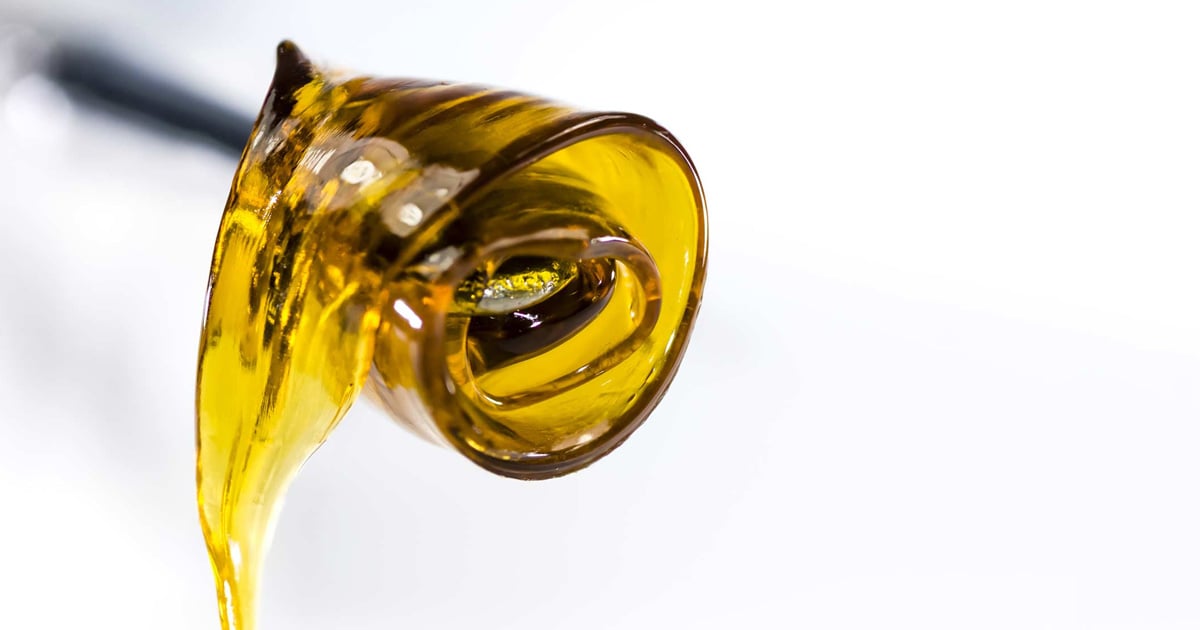
What makes extracts and concentrates so popular? For many consumers, it is a combination of accessibility, portability, and versatility, which combine to provide a much more user-friendly experience. The many choices of receptacle give consumers options for consumption on their own terms. Portability furthers this access by opening up new options for environmental settings, indicating a more freeing experience. And versatility means it can be packaged in a variety of ways, with different elements isolated to deliver any intended effect, thereby serving a wide swath of needs and preferences.
Accessibility, portability, and versatility are the primary drivers of consumer demand in the concentrates segment.
For producers, concentrates represent a highly scalable, highly profitable option. Concentrates ship easier and keep longer, cutting down on distribution costs. They can be bud-based (nug run) or made from trim and leaf depending on the desired output quality and type, allowing for more flexibility during processing. Perhaps most importantly, product consistency is easier to attain with the standardized processes of the more technologically advanced processors.
But there is the problem of addressing the hundreds of new demands being placed on producers. While consumers are free to choose their favorite means, producers are left chasing their tails. Not only does the popularity of individual strains change with the seasons, now new variables exist for consumer preference in packaging (pens, droppers, canisters), flavors (infused, flavorless, natural), and forms (tinctures, gummies, salves, vapor).
BHO specifically addresses the multitude of consumer choices and demands better than other methods because of three little words unique to BHO — full spectrum extraction.
Full spectrum extraction means the fullest representation of the plant in concentrated form. Most extraction methods, including both cruder means such as alcohol extraction and highly advanced means like CO2, exist for one primary purpose — to extract THC and/or CBD. BHO extraction, on the other hand, pulls cannabinoids, THC, terpenes, flavonoids, phenolic amides, and sterols to create a full spectrum representation of the original plant in concentrated form, with all the flavors intact.
As opposed to other extraction methods, BHO extraction pulls cannabinoids, THC, terpenes, flavonoids, phenolic amides, and sterols to create a full representation of the original plant in concentrated form.
It is easy to see why this would be desirable. More elements mean more versatility, depth and variety of flavor, and an enhanced experience, which is the name of the concentrate game for consumers.
For a list of full spectrum extraction benefits, see https://www.ncbi.nlm.nih.gov/pmc/articles/PMC3165946/.
In any extraction process, the ability to accurately measure and control product quality consistently while also being able to scale production is paramount to the success and viability of the business. With no single governing body, there is very little consistency in quality and potency of oil extracted by the thousands of producers out there. Additionally, CO2 extraction requires an additional step of removing unwanted components through distillation.
For example, patients who use CBD oil for cancer treatment or other ailments don’t want any trace of THC in their oil. Unfortunately, this unregulated industry means this is not always guaranteed. In fact, most CBD oil contains at least trace amounts of THC. Further, a study by the CDC in May 2018 highlighted the practice of some manufacturers using synthetic marijuana instead of CBD in their oil, which resulted in the poisoning of 50 people in Utah. The onus falls on the producers and processors to self-regulate their processes and be accountable to the end product.
CBD oil contains at least trace amounts of THC.
That is what makes the right equipment so important.
Key Factors of BHO Extraction Equipment
The cost of a BHO extractor can vary by thousands — even hundreds of thousands — of dollars. The discrepancy depends largely on four factors: ease of use, product quality desired, throughput, and safety. BHO extraction methods range from the rudimentary (and extremely dangerous) practice of blasting it in a PVC tube to make single batches, to fully automated light hydrocarbon extraction solutions that can process hundreds of pounds of plant material each day.
For commercial producers and processors, these factors deserve a closer look:
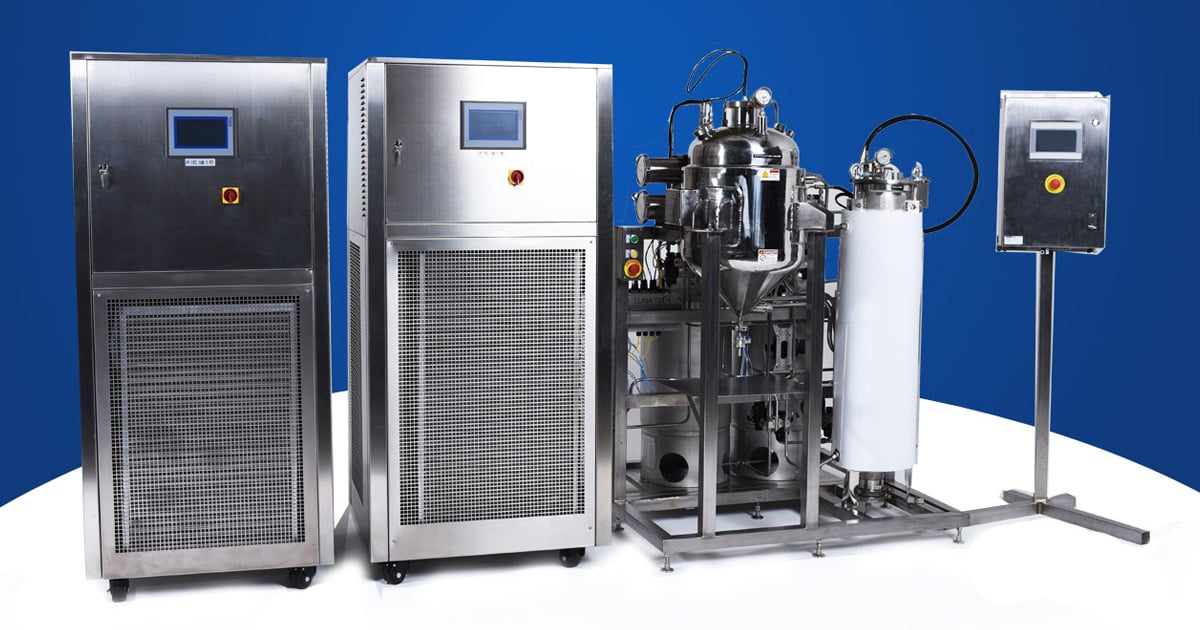
Ease of Use
Like any industry, the labor costs involved in creating cannabis concentrates are heavily intertwined with the process. BHO extraction, in particular, can be very labor-intensive due to the sensitivity of the process; poor timing, improper technique, or a missed step can result in thousands of dollars lost in a matter of minutes.
Historically, this has made scalability difficult for BHO extractors without significant investment in both labor and equipment. Extensive training is required to operate many of the manual machines, which themselves can be complicated and expensive.
Now, there are fully automated extractors — such as our own IO extractor — which significantly reduce labor costs and provide a path to growth and scalability.
Let's look at an example from Claywolf, who recently moved from a manual operation to the automated Luna IO extractor:
Before investing in an automated BHO extractor, Claywolf employed 7 full-time operators, each working full-time shifts and operating two separate extractors. They processed a maximum of 20 pounds of biomass per day. After implementation of the IO extractor, Claywolf was able to process 160 pounds per day, using only one technician and one extractor. The combination of throughput and labor savings resulted in significant profitability improvements.
These solutions don’t come cheap, but the cost savings and growth potential make the ROI difficult to ignore. Coupled with the aforementioned superiority and versatility of the product, it is easy to see why many companies are making the leap to automated hydrocarbon extraction.
Product Quality
When done correctly, BHO extraction results in consistently higher cannabinoid count, wider terpene profile, lighter color, and better flavor than other extraction methods. However, there are a multitude of factors that can impact the final outcome, and controlling each of these presents their own unique challenges.
When done correctly, BHO extraction results in consistently higher cannabinoid count, wider terpene profile, lighter color, and better flavor than other extraction methods.
Perhaps the most important factor impacting product quality during the extraction process is temperature control. Extracting at lower temperatures creates a purer product by fully separating the lipids from the waxes. When considering a BHO extractor, cooling power and cooling consistency are two of the most important factors to take into account. This is especially crucial for live resin, which is extremely sensitive to temperature fluctuations.
Throughput
Home growers and mom-and-pop operations may not recognize the huge advantages of automated BHO extraction, or comprehend why a capital outlay in the hundreds of thousands of dollars would be necessary.
But these are not the good old days. High-volume production is a prerequisite to remaining relevant and competitive in today’s high-growth cannabis industry.
Companies such as Tilray, Canopy, and Aurora boast multi-billion dollar investment rounds and stock valuations. In many states, including Arizona, Colorado, California, and Oregon, cannabis is being cultivated in greenhouses in excess of 250,000 square feet, producing more than 50,000 pounds of flower. Large-scale Canadian producers are building greenhouses in the millions of square feet. Companies that do not have long-term, sustainable solutions for processing concentrates will quickly find themselves on the outside looking in
Companies that do not have long-term, sustainable solutions for processing concentrates will quickly find themselves on the outside looking in.
Throughput is the most important factor in the ROI equation, and BHO wins the day by a large margin against CO2: Average CO2 throughput is 1/5 (or less) than BHO equipment with comparable capital outlay, and we often encounter clients that over-purchase CO2 equipment even though the IO produces more than CO2 equipment at approximately 1/10th the cost.
CO2 equipment is inefficient. BHO extraction can achieve 5-10x throughput of today’s standard CO2 equipment with the same capital outlay.
Safety
Perhaps the most important aspect of hydrocarbon extraction is safety. Over the years, BHO has had to overcome its share of bad news in the safety department. Butane is relatively inexpensive, which leads to a low barrier to entry for backyard operations. Lack of understanding of its elements and proper precautionary measures have led to some unfortunate events, even costing lives.
This has allowed “safer” alternatives like CO2 to grab market share even though the end product is far inferior to BHO. Not only that, but these
Another word on safety:
Despite the regulatory advances made, BHO still has a safety stigma attached to it, both in terms of processing safety and consumption. But the reality is, each extraction method has its own risks. Ethanol and butane are flammable, CO2 is under high pressure. BHO extraction has come a long way in the past few years, with self-contained units that safely capture and reuse excess butane. These commercial grade “closed-loop” systems keep flammable solvents from escaping and getting exposed to open air, thereby limiting the risk of explosion.
Some companies are taking their safety directive a step further and incorporating Recognized and Generally Accepted Good Engineering Practices (RAGAGEP) throughout the design and manufacturing of equipment. Automation also lends a huge assist in the safety department; by automating processes that are otherwise performed by humans, processors thereby eliminate exposure to risk. More layers of safety in both operations and processes mean less safety liability and a better product for consumers and producers alike.
IO Extractor
The IO Extractor is a fully automated BHO extraction system capable of extracting essential oils from 18 pounds of dried plant material per hour. By taking the process control out of the hands of technicians, the IO Extractor maintains product quality run after run. Additionally, with a full data-logging suite, process parameters can be refined to a level previously unavailable to BHO extractors. Temperatures, pressures, and event logs can be reviewed for each step of the extraction process cycle to develop strain-specific recipes and support quality assurance.
Additional BHO Extraction Resources:
BHO 201: Post-Processing and Vacuum Ovens
Getting to Know (and Love) Butane
BHO Stigma — Truths, Misconceptions & Falsehoods of Butane Hash Oil
Butane Hash Oil (BHO) Frequently Asked Questions
